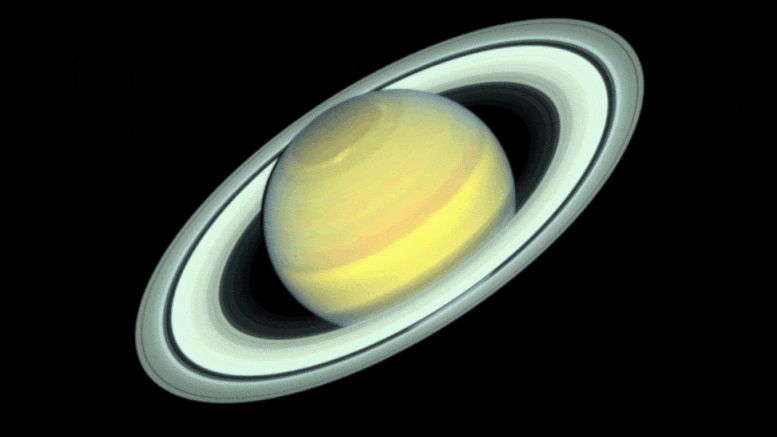

NASA‘s Hubble Space Telescope gives astronomers insight into changes in Saturn‘s vast and turbulent atmosphere as the summer of the planet’s northern hemisphere turns into autumn, as seen in this series of photos taken in 2018, 2019 and 2020 (left to right).
“These small year-to-year changes in Saturn’s color bands are fascinating,” said Amy Simon, planetary scientist at NASA’s Goddard Space Flight Center in Greenbelt, Maryland. “As Saturn moves down in its Northern Hemisphere, we see the polar and equatorial regions change, but we also see the atmosphere vary on much shorter time scales.” Simon is lead author of a paper on these observations, published March 11, 2021 in Planetary Science Journal.
“What we found was a slight change from year to year in color, possibly cloudiness and wind – unsurprisingly, the changes aren’t huge, considering we’re only looking at a small portion of a Saturn year,” added Simon. “We expect big changes on a seasonal timetable, so this shows progress to the next season.”

Hubble Space Telescope images of Saturn taken in 2018, 2019 and 2020 as summer from the planet’s northern hemisphere turns into fall. Credit: NASA / ESA / STScI / A. Simon / R. Roth
The Hubble data shows that the equator became 5 to 10 percent brighter from 2018 to 2020 and the wind changed slightly. In 2018, winds measured near the equator were about 1,000 miles per hour (about 1,600 kilometers per hour), higher than those measured by NASA’s Cassini spacecraft in 2004-2009, when they were about 800 miles per hour (about 1,300 kilometers per hour). In 2019 and 2020 they dropped back to Cassini speeds. Saturn’s winds also vary with height, so the change in measured speeds could potentially mean that in 2018 the clouds were about 37 miles (about 60 kilometers) deeper than those measured during the Cassini mission. Further observations are needed to determine what is going on.
Saturn is the sixth planet from our sun and orbits about 886 million miles (1.4 billion kilometers) from the sun. It takes about 29 Earth years to orbit the sun, making each season on Saturn more than seven Earth years. Earth is tilted relative to the sun, which changes the amount of sunlight each hemisphere receives as our planet moves in its orbit. This variation in solar energy is what drives our seasonal changes. Saturn is also tilted, so as the seasons on that distant world change, the change in sunlight can cause some of the observed atmospheric changes.
Like it JupiterSaturn, the largest planet in the solar system, is a “gas giant” composed mainly of hydrogen and helium, although deep inside there may be a rocky core. Huge storms, some nearly the size of Earth, occasionally erupt deep into the atmosphere. Since many of the planets discovered around other stars are also gas giants, astronomers would like to learn more about how gas giants work.
Saturn is the second largest planet in the solar system, more than 9 times wider than Earth, with more than 50 moons and a spectacular ring system composed mostly of water ice. Two of these moons, Titan and Enceladus, appear to have oceans beneath their icy crusts that could support life. Saturn’s largest moon, Titan is the only moon in our solar system with a thick atmosphere, including clouds that rain liquid methane and other hydrocarbons to the surface, forming rivers, lakes and seas. This mix of chemicals is thought to be similar to those on Earth billions of years ago, when life first emerged. NASA’s Dragonfly mission will fly over Titan’s surface and land in various locations to search for the original building blocks of life.
Reference: “Midsummer Atmospheric Changes in Saturn’s Northern Hemisphere from the Hubble OPAL Program” by Amy A. Simon, Ricardo Hueso, Agustín Sánchez-Lavega and Michael H. Wong, March 11, 2021, Planetary Science Journal
DOI: 10.3847 / PSJ / abe40f
The Saturn observations are part of Hubble’s Outer Planets Atmospheres Legacy (OPAL) program. “The OPAL program allows us to observe each of the outer planets with Hubble every year, enabling new discoveries and seeing how each planet changes over time,” said Simon, OPAL principal investigator.
The Hubble Space Telescope is a project of international collaboration between NASA and ESA (European Space Agency). NASA’s Goddard Space Flight Center in Greenbelt, Maryland operates the telescope. The Space Telescope Science Institute (STScI) in Baltimore conducts Hubble science operations. STScI is administered for NASA by the Association of Universities for Research in Astronomy in Washington, DC